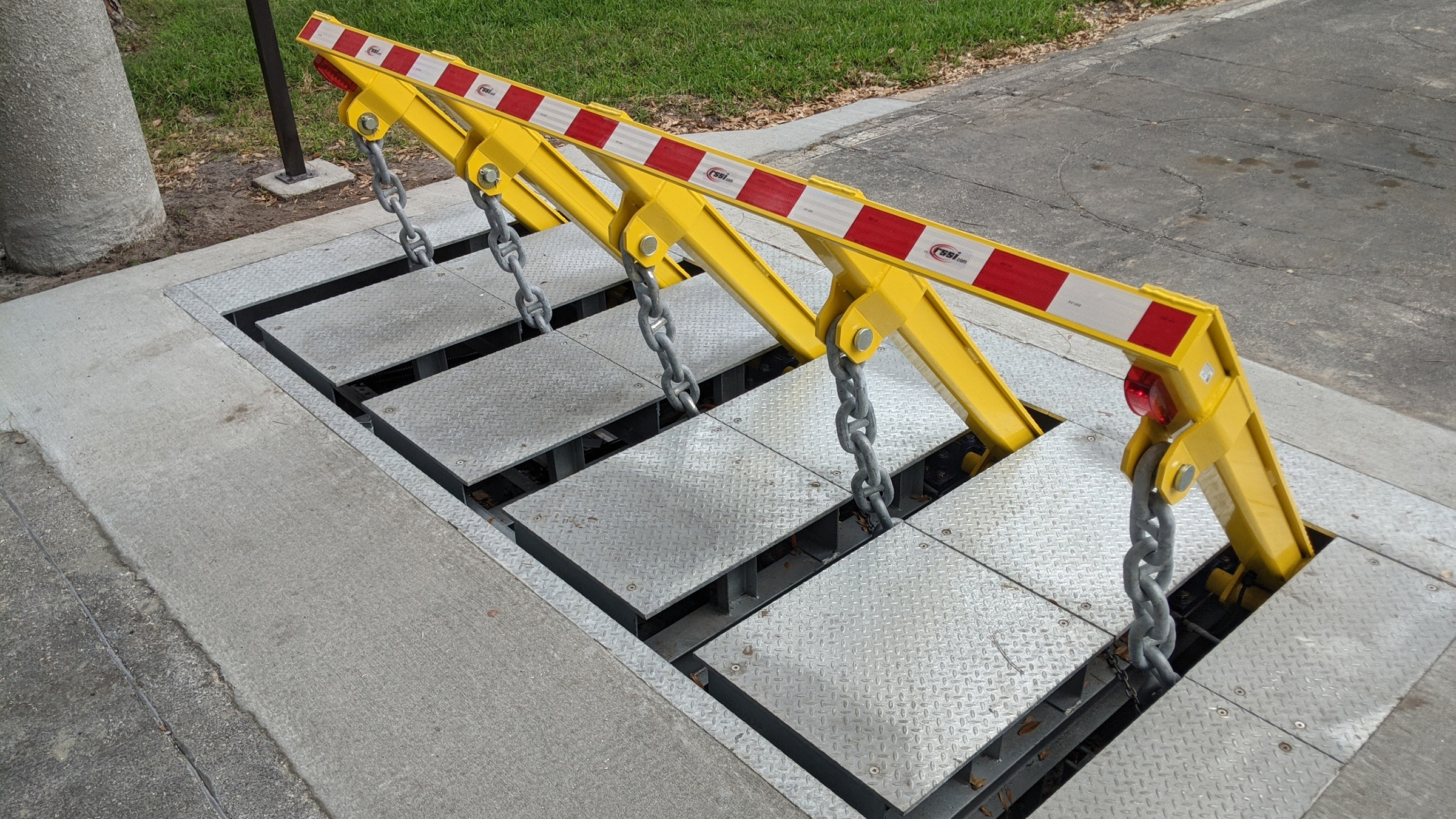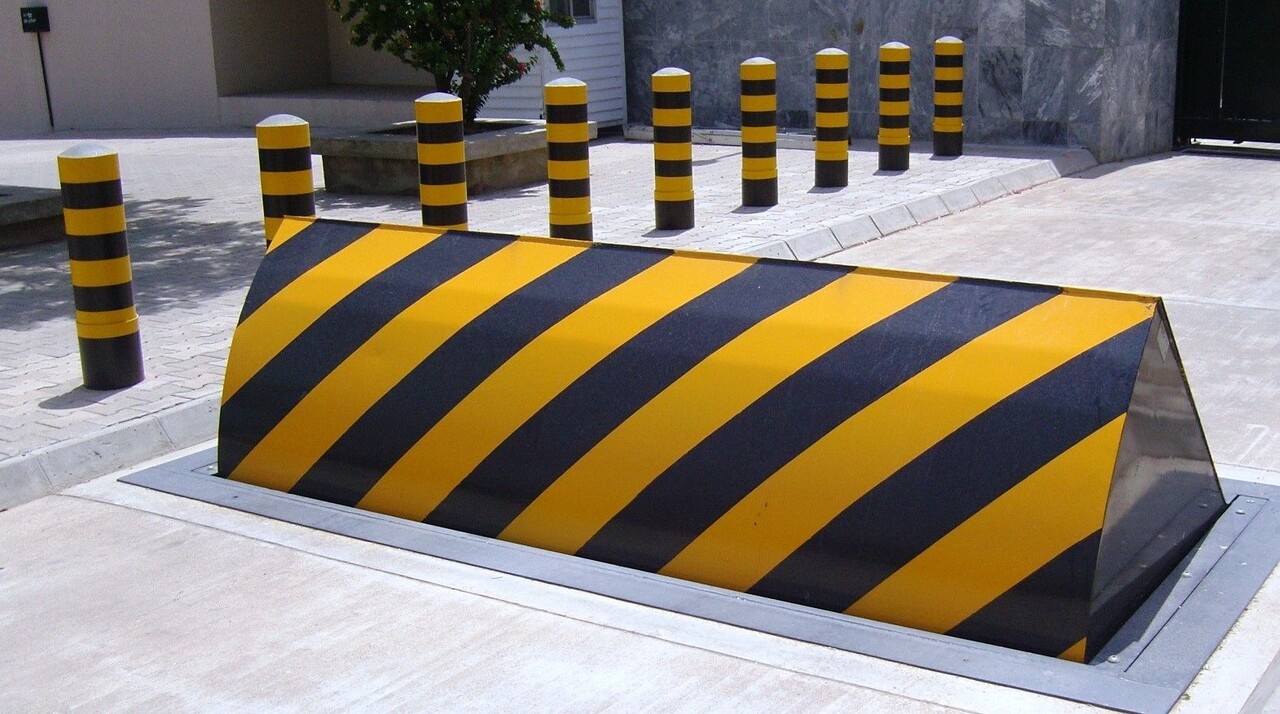The Wedge Barriers Statements
Table of ContentsThe Greatest Guide To Wedge BarriersThe Best Guide To Wedge Barriers


18 may be done faster, conveniently, and price successfully. FIG. In particular embodiments, the support 30 may be a steel structure including plates, light beams(e. g., I-beams ), and/or other frameworks that are safeguarded within the foundation 14, which might be concrete. At the surface 12, a top side 28 of the support 30 may go to the very least partially revealed
, consequently enabling the add-on of the barrier 10 to the support 30. g., threaded openings)in several beam of lights or plates of the anchor 30 may be revealed to the surface area 12. In this manner, screws 32 or various other mechanical fasteners might be made use of to secure the obstacle 10 to the support 30. As the barrier 10 is installed to the surface area 12 of the structure 14, collection of debris and various other product beneath the barrier might be decreased, and elements of the bather 10 may not be revealed to below quality atmospheres. As indicated by referral character 52, the lifting mechanism 50 includes components disposed beneath the wedge plate 16. As an example, the elements 52 underneath the wedge plate 16 may consist of an electromechanical actuator, a camera, several webcam surface areas, and so forth. In addition, the training device 50 consists of a spring assembly 54
The spring rod 58 is coupled to a webcam(e. g., camera 80 received FIG. 4) of the training device 50. The springs 60 disposed regarding the springtime pole 58 are held in compression by springtime supports 62, consisting of a dealt with springtime assistance 64. That is, the set springtime support 64 is taken care of about the structure 14 et cetera of the bather 10.
Indicators on Wedge Barriers You Should Know
The continuing to be pressure used to
the cam camera deploy release wedge plate 16 may be provided offered an electromechanical actuator 84 or other various other. The spring assembly 54 and the actuator 84(e. Wedge Barriers. g., electromechanical actuator)may operate with each other to convert the webcam and lift the wedge plate 16.
As pointed out above, the spring setting up 54 exerts a continuous pressure on the web cam, while the electromechanical actuator may be controlled to put in a variable pressure on the web cam, thereby enabling the lifting and reducing( i. e., releasing and withdrawing )of the wedge plate 16. In certain embodiments, the continuous pressure used by the spring assembly 54 may be adjustable. g., electromechanical actuator) is disabled. As will be valued, the springtime setting up 54 might be covered and protected from debris or other components by a cover plate(e. g., cover plate 68 shown in FIG. 4) that may be considerably flush with the raised surface area 38 of the see this structure 14. As stated over, in the released placement, the wedge plate 16 offers to obstruct gain access to or traveling beyond the barrier 10. The barrier 10(e. g., the wedge plate 16 )might obstruct pedestrians or automobiles from accessing a building or path. As reviewed over, the obstacle 10 is affixed to the support 30 safeguarded within the structure 14,

front brackets 71. Consequently, the affiliation assemblies 72 may pivot and turn to make it possible for the collapse and extension of the link assemblies 72 throughout retraction and release of the bather 10. The linkage assemblies 72 cause motion of the wedge plate 16 to be limited. As an example, if an automobile is taking a trip towards the released wedge plate 16(e. As an example, in one scenario, the security legs 86 might be extended duringmaintenance of the obstacle 10. When the safety and security legs 86 are released, the safety legs 86 support the weight of the wedge plate 16 versus the surface 12. Consequently, the lifting device 50 may be shut down, serviced, gotten rid of, replaced, and so forth. FIG. 5 is partial perspective sight of an embodiment of the surface-mounted wedge-style obstacle 10, illustrating the webcam 80 and the cam surface areas 82 of the lifting system 50. Especially, two camera surface areas 82, which are referred to as lower webcam surface areas 83, are positioned below the web cam 80. The lower webcam surface areas 83 go to website might be fixed to the surface 12 (e. For instance, the reduced web cam surface areas 83 and the placing plate 85 may develop a single piece that is protected to the support 30 by bolts or other mechanical fasteners. Additionally, two webcam surfaces 82, which are referred to as upper camera surfaces 87, are placed above the cam 80 and coupled to (e. In various other embodiments, stepping in layers or plates may be placed between the surface 12 and the reduced webcam surface areas 83 and/or the wedge plate 16 and the upper cam surface areas 87 As mentioned over, the web cam
80 translates along the webcam surfaces 82 when the wedge plate 16 is lifted from the retracted position to the released setting. Furthermore, as stated above, the springtime setting up 54 (see FIG. 3 )might offer a pressure acting upon the webcam 80 in the instructions 102 via springtime rod 58, which may minimize the pressure the electromechanical actuator 84 is needed to relate to the webcam 80 in order to actuate and lift the wedge plate 16. 1 )to the released setting(see FIG. 4). As discover this revealed, the cam 80 includes track wheels 104(e. g., rollers), which call and translate along the camera surfaces 82 throughout operation.